As we navigate the complex landscape of legal protections for disabled students facing bullying, it's essential to understand the rights and options available under laws like IDEA, Section 504A provision of the Rehabilitation Act of 1973 that prohibits discrimination based on disability in p..., and the ADA. These regulations guarantee accommodationsModifications or adjustments in healthcare settings to support patients with disabilities. and guard against harassment. But what happens when these measures aren't enough? Let's explore how schools are obligated to act and what steps we can take when interventions fall short.
Key Takeaways
- Disabled students can utilize IDEA for tailored education plans that include anti-bullying measures.
- Section 504 mandates schools to provide accommodations and address disability-based harassment promptly.
- The ADA prohibits discrimination and requires schools to act on bullying incidents involving disabilities.
- Detailed documentation of bullying incidents is crucial for pursuing legal actions and ensuring accountability.
- Legal aid organizations and disability rightsThe legal and human rights afforded to individuals with disabilities, often the focus of advocacy an... advocates offer support for navigating bullying-related legal issues.
Understanding the Individuals With Disabilities Education Act (IDEA)
When exploring the Individuals With Disabilities Education Act (IDEA), we find that it's an essential piece of legislation ensuring students with disabilities receive a free and appropriate public education tailored to their unique needs.
IDEA mandates public schools to create an Individualized Education Program (IEP)A plan developed for U.S. students with disabilities to ensure they receive tailored educational ser... for each eligible student. This IEP outlines specific educational goals and the support services required to achieve them, fostering an inclusive learning environment.
We recognize that IDEA also emphasizes the importance of ensuring students are educated in the least restrictive environment possible. By doing so, students with disabilities can learn alongside their peers, promoting social integrationThe process of enabling individuals with disabilities to participate fully in society, including in ... and understanding.
As we engage with IDEA, we see its role in protecting rights and providing essential educational opportunities to students with disabilities.
The Role of Section 504 of the Rehabilitation Act

Let's explore how Section 504 of the RehabilitationThe process of helping individuals with disabilities achieve and maintain their optimal physical, se... Act provides essential protections for students with disabilities facing bullying.
It addresses disability-based harassment and outlines schools' legal obligations to prevent and respond to such incidents.
Protections Under Section 504
Though often overlooked, Section 504 of the Rehabilitation Act plays a crucial role in protecting disabled students from bullying in educational settings.
We must understand that this federal law guarantees students with disabilities equal accessThe principle that all individuals, including those with disabilities, should have equal opportunity... to educational opportunities and services. It mandates schools to provide appropriate accommodations, fostering an environment where all students feel safe and respected.
When bullying interferes with a student's right to an education, schools are required to take immediate action. They must assess the situation, implement strategies to stop the bullying, and prevent it from recurring.
We should remember that Section 504 doesn’t just offer protections; it holds schools accountable. This accountability empowers us to advocate for and support disabled students, guaranteeing their educational environments remain inclusive and nurturing.
Addressing Disability-Based Harassment
Addressing disability-based harassment requires a focused understanding of how Section 504 of the Rehabilitation Act empowers us to protect students from such harmful behaviors. This federal law guarantees that students with disabilities receive equal access to education in a safe environment. It prohibits discrimination and mandates that schools provide necessary accommodations and modifications.
When students face harassment based on their disabilities, Section 504 gives us a foundation to advocate for corrective measures. We can work with schools to develop strategies that prevent and address harassment effectively.
Schools' Legal Obligations
When examining schools' legal obligations under Section 504 of the Rehabilitation Act, it's clear that they've a duty to guarantee a non-discriminatory educational environment for students with disabilities.
We must understand that schools are required to take immediate and appropriate action when disability-based bullying occurs. This isn't just about compliance; it's about protecting our children’s right to learn without fear.
To emphasize the emotional weight of these obligations, consider these points:
- Accountability: Schools must identify and address bullying promptly.
- Safety: They must provide a safe and supportive environment.
- EquityFairness and justice in the way people are treated, especially in the allocation of resources and op...: Every student deserves equal access to educational opportunities.
- Support: Schools should provide necessary resources and assistance.
Together, we can guarantee that every child feels valued and protected.
How the Americans With Disabilities Act (ADA) Protects Students
While traversing the complexities of education, students with disabilities are afforded protections under the Americans With Disabilities Act (ADA)A U.S. law that prohibits discrimination against individuals with disabilities in all areas of publi....
This pivotal legislation guarantees equal access to educational opportunities and prohibits discrimination based on disability. It means schools must provide reasonable accommodations, creating environments where all students can thrive.
If a student faces bullying due to their disability, the ADA mandates that schools take appropriate action to address it.
Identifying Bullying and Discrimination
Understanding how the ADA supports students is essential, but equally important is recognizing when bullying and discrimination occur. We must be vigilant in identifying these harmful behaviors to protect our community.
Bullying and discrimination can be subtle or overt, and it’s vital to be aware of the signs. Here are some indicators:
- Isolation: If a student is frequently left out or shunned by peers, it might be a sign of targeted exclusion.
- Verbal Abuse: Name-calling, insults, or mocking a student’s disability are clear forms of bullying.
- Physical Aggression: Unwanted physical contact or threats can create a hostile environment.
- Cyberbullying: Online harassment, spreading rumors, or sharing hurtful content is equally damaging.
Reporting and Documenting Incidents of Bullying

When confronting bullying, we're more effective when we keep detailed records of each incident.
Documenting what happened, who was involved, and when it occurred is vital for building a strong case.
Let's explore how we can report these incidents effectively to guarantee that disabled students receive the support and justice they deserve.
Importance of Detailed Records
Keeping detailed records of bullying incidents is essential in advocating for disabled students' rights. When we document every incident, we can build a compelling case that highlights the struggles these students face. It helps us understand the severity and frequency of the bullying.
To evoke a sense of urgency and empathyThe ability to understand and share the feelings of another, particularly important in understanding..., consider the following:
- Helplessness: Without records, students may feel their voices are unheard.
- Safety: Detailed accounts can create a safer environment by holding bullies accountable.
- Justice: Accurate records provide a clearer path to legal recourse and justice.
- EmpowermentThe process of gaining control, authority, and power over one’s life, often used in the context of...: Students gain strength knowing their experiences are validated and taken seriously.
Let's guarantee these students are heard and supported through thorough documentation. Our efforts can make a difference.
Steps for Effective Reporting
To effectively report and document incidents of bullying, we must adopt a systematic approach that guarantees every detail is captured.
First, we should record the date, time, and location of each incident. This helps establish patterns and provides context.
Next, let's document the specific actions and words used by the bully. It’s vital to be as detailed as possible to paint a clear picture.
We also need to gather evidence, like photos or messages, and note any witnesses who can corroborate our account.
Don’t forget to keep copies of reports and correspondence with school officials.
Legal Obligations of Schools to Prevent Bullying
Although schools are bustling with academic and social activities, they've a critical duty to guarantee a safe environment for every student, including those with disabilities.
Our children deserve to learn without fear of bullying, and schools are legally obligated to protect them.
Here’s what schools must do:
- Implement Anti-Bullying Policies: They should have clear, accessible policies that explicitly prohibit bullying and outline consequences.
- Provide Staff Training: Educators and staff need training on recognizing and addressing bullying, especially against disabled students.
- Ascertain Proper Supervision: Increased supervision in areas where bullying often occurs can deter harmful behavior.
- Foster an Inclusive Culture: Schools should actively promote acceptance and empathy, making diversityThe inclusion of individuals from a wide range of backgrounds, including people with disabilities. a celebrated norm.
Together, we can ascertain that schools fulfill these obligations.
Steps to Take When School Interventions Fail
When school interventions fall short, it's crucial that we, as advocates for our children, know the appropriate steps to take.
First, we should document every incident of bullying, including dates, times, locations, and any communication with school officials. This record will support our case if needed.
Next, let's request a meeting with school administrators to discuss our concerns. Having clear documentation will strengthen our position.
If this doesn't resolve the issue, we can escalate by contacting the school district or board of education. They've a responsibility to guarantee a safe environment for our children.
It's also helpful to connect with other parents facing similar issues for support and to strengthen our collective voice. Together, we can advocate effectively for our children's rights.
Seeking Legal Assistance and Advocacy Support

While engaging with school administrators and the school district can sometimes yield positive results, there are instances when these efforts don't suffice. It's then that we must consider seeking legal assistance and advocacyThe act of arguing in favor of, supporting, or defending the rights and interests of individuals or ... support.
We aren't alone in this fight, and several options can guide us through these challenging times:
- Legal Aid Organizations: They offer free or low-cost legal services, making certain we comprehend our rights.
- Disability Rights Advocates: These professionals work tirelessly to uphold the rights of disabled students.
- Special EducationCustomized educational programs designed to meet the needs of students with disabilities. Attorneys: They specialize in cases involving educational rights, providing expertise in maneuvering complex legal systems.
- Support Groups: Connecting with others who've faced similar challenges can provide emotional strength and practical advice.
Together, we can advocate for justice and make sure our voices are heard.
Frequently Asked Questions
How Can Parents Support Their Child Emotionally After a Bullying Incident?
We can support our child by listening to them, validating their feelings, and encouraging open communication. Let's reassure them they're not alone and work on building their confidence through positive reinforcement and involvement in supportive activities.
What Are Some Signs That a Disabled Student Might Be Experiencing Bullying?
We can recognize signs like withdrawal, anxiety, or unexplained injuries in disabled students experiencing bullying. Let's stay observant and communicate openly, ensuring they feel supported and safe. Recognizing these signs helps us act promptly and effectively.
Are There Any Online Resources for Disabled Students Facing Bullying?
We can find several online resources to support disabled students facing bullying. Websites like StopBullying.gov and PACER's National Bullying Prevention Center offer guides, toolkits, and hotlines. Let's explore these resources together and empower each other.
How Can Peer Support Programs Help Disabled Students Facing Bullying?
Peer supportA system where individuals with disabilities provide support and share experiences to help each othe... programs empower us to create inclusive environments where disabled students feel safe and valued. By fostering empathy and understanding, we can directly combat bullying and build a community that stands united against discrimination.
What Role Do Mental Health Professionals Play in Supporting Bullied Disabled Students?
Mental health professionals provide essential support by offering counselingProfessional guidance to help individuals cope with emotional, mental, or social challenges, particu..., developing coping strategies, and fostering resilienceThe ability of individuals with disabilities to cope with and adapt to challenges and adversity.. They work with us to create safe environments, promote understanding, and guarantee that bullied disabled students feel heard and supported.
Conclusion
As we've explored, disabled students have robust legal protections against bullying, thanks to IDEA, Section 504, and the ADA. It's essential we identify and document bullying incidents to guarantee schools meet their legal obligations. If school interventions fall short, let's not hesitate to seek legal assistance and advocacy support. Together, we can create a safe and inclusive educational environment where every student can thrive without fear of harassment or discrimination.






